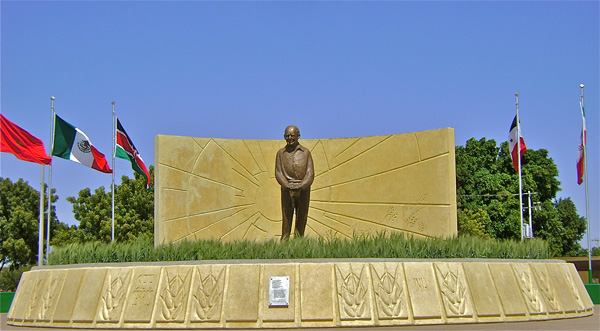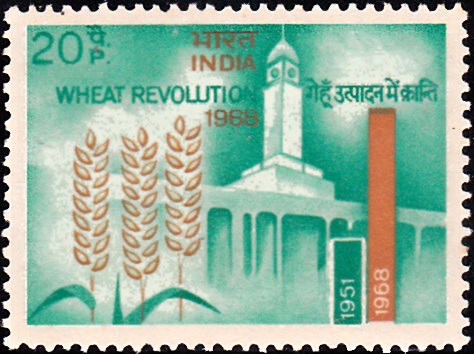
Epic narratives of the Green Revolution: perspectives from Brazil, China and India
The Green Revolution (GR) is often portrayed as the advent of scientific and technological modernity in agriculture, which helped countries to avert famines and revert food deficits. Unfolding between the late 1940s and 1980s, the GR was a state-led process that involved the roll-out of high-yielding varieties responsive to high inputs of chemical fertilizers and irrigation. The aim was to intensify production and productivity, and address pressing concerns related to hunger, social stability, and industrial development.
Despite the time that has elapsed, and mounting evidence on its social and environmental costs, the GR continues to influence perspectives and practices in agricultural science and technology worldwide. Calls for a second green revolution, a doubly green revolution, and an evergreen revolution illustrate the GR’s enduring influence. So through what processes does the GR legacy endure and why?
This post summarises findings from a research project on the narrated histories of the GR in Brazil, China and India that aims to shed light on how national histories, organizations, individuals, and ideas about modernization and development have been combined to produce meaning and empower actors in science and technology (S&T) systems. We refer to this process of subjective history-making as epic narration.
Epic narratives
Epic narratives portray the GR as resulting from a strong, state-led sense of urgency and purpose, which motivated highly trained scientists and technicians (some of them becoming legendary figures, such as Norman Borlaug, MS Swaminathan and Yuan Longping) to work hard to deliver great scientific feats, such as new wheat, rice, and soybean varieties that were high-yielding and pest-resistant.
In India, the GR was about averting a famine and asserting post-colonial national sovereignty, and centred on adapting high-yielding varieties of wheat developed in Mexico by Borlaug and team. Brazil’s “tropical revolution” was about making the country food self-sufficient and supporting industrialization by modernising the hinterland and, specifically, taming the “unproductive” Cerrado (Brazil’s savannah-like biome, covering about 24% of the country’s territory) largely by enabling soybean cultivation at scale in a tropical environment. In China, “scientific farming” entailed the development of high-yielding rice by leading scientists alongside an approximation of science to grassroots knowledge, in a context where state provision was key to ensure social stability of a newly established country.
Memorial to GR hero Norman Borlaug, Mexico.
Source: https://www.apsnet.org/edcenter/apsnetfeatures/Pages/NormanBorlaug2.aspx
How are epic narratives assembled?
Epic narratives are assembled through symbols, celebration of heroes, and construction of history-rooted identity or heritage, which seal off the epic moment as distant, finished, and hierarchically superior.
In India, the government issued, in 1968, a special postage stamp with the title “wheat revolution”. The stamp symbolized the role of science in transforming the yield potential of wheat. The Indian GR epic has been communicated to the public through colourful displays of several such stamps over the years, contributing to keeping the memory of the GR alive. These stamps have highlighted different aspects of the GR such as domestic fertilizer production, irrigation through dams, agricultural machinery such as tractors, storage facilities, and India’s declaration of self-sufficiency in food grains.
In Brazil, the epic celebration is visible in the commemoration of the 40th anniversary of the Brazilian Agricultural Research Corporation (Embrapa), which is often portrayed as the organisational hero of the tropical revolution that started in the 1970s. In 2013, the celebratory initiative Memória Embrapa paid tribute to Embrapa’s history and the contributions of its scientists, including the consolidation of farming in the Cerrado, placing Brazil in the frontline of tropical agricultural science, and feeding the world. The scientific heritage celebrated by Memória Embrapa is connected to productive intensification and a view of the farmer as passive taker of technologies developed by experts. This officialised memory simplifies a complex and diverse history of agricultural development, purges it of contestations, and ignores experimentation with multiple approaches to scientific and technological innovation that do not fit the cannons.
Commemorative post stamp on the Indian wheat revolution.
Source: https://www.istampgallery.com/wheat-revolution/
Why are epic narratives deployed?
The narration of an epic is not a neutral act of historical reconstruction or nostalgic recollection but an active exercise of history-making that performs a role. Several factors explain the deployment of epic narratives, according to our research. These include: the drive for self-preservation by leading S&T organizations (particularly in Brazil and India); efforts by states and S&T corporations to harness public trust in technology (especially in India and China); and the construction of a national scientific identity that enables these Southern countries to assert themselves internationally.
For example, in Brazil and India, the epic narration of the GR is a performance by leading players of the agricultural S&T system, whose history and identity are tightly linked to the GR. It reflects an effort to preserve their credibility and position in the system, in response to the accumulation of evidence interrogating the extent of achievements and negative social and environmental impacts. It is also a reaction to the increasingly articulate and forceful critique to productive intensification that unfolded since the mid-1980s and the early 1990s, including from within the agricultural sciences.
In China, the celebration of scientific farming has helped to consolidate a narrative of non-Western exceptionalism. Scientific farming “with Chinese characteristics” connects scientific advancement with the imperative of state provisioning for the collective good. The direct link between scientists and the peasantry, pushed by the state during the Cultural Revolution, defined China’s GR epistemology, which combined peasant wisdom, party ideology, and modern technology. Recently, biotechnology hardened hierarchical relationships between scientists and grass-roots technicians. It has also brought into the system new, private players and concerns over the quality and safety of food. In this setting, reinstating the link between the state and collective wellbeing is part of a nation-building process where the state pays attention not only to its rural producers but also its increasingly enlightened food consumers.
Towards more plural and political histories
Despite common claims that science is a neutral domain free of politics, the assemblage of GR narratives of science-led and yields-centric success is a deeply political undertaking, which concerns state-building, institutional preservation, and the affirmation of ideas and imaginaries about scientific advancement that are aligned with the hegemonic agricultural modernization project and the interests of its dominant players.
Moving towards more plural and openly political histories of agricultural S&T in development requires an active effort of articulating alternative historical pathways and giving voice to a more diverse set of actors. There is a gap to be filled in assembling other agricultural histories, beyond the institutionalised (and inevitably sanitised) versions of these countries’ research institutions, that shed light on forgotten accomplishments, milestones, and heroes, including the contributions of women that are rendered invisible by male-centric epics.
This post is a summary of the paper “Epic narratives of the Green Revolution in Brazil, China, and India” published by Agriculture and Human Values.
*Post signed by Lídia Cabral, Poonam Pandey and Xu Xiuli
Lídia Cabral is a Research Fellow at the Institute of Development Studies, University of Sussex. She is a social scientist with training in development economics, social policy and development studies. Her research looks at the politics of agrifood science and technology and South-South relations. She coordinates research on the histories of the Green Revolution, looking at how epic narratives of the past shape contemporary transactions of technology in the global South. She is also developing research on food networks in the context of the Covid-19 pandemic across countries in the global North and South. She co-convenes the Development Studies Association Study Group on the Rising Powers.
Poonam Pandey is an interdisciplinary researcher with training in agricultural biotechnology. Her advanced training comprises the fields of science policy, innovation studies, developmental studies and Science and Technology Studies. She is currently engaged in two broader themes related to agriculture: one concerning the vulnerability of agri-food systems in relation to international and national pressures of food and energy security; and a second one related to the role of socio-technical imaginaries such as the green revolution and the gene revolution in shaping future R&D trajectories of agriculture in the global South.
Xu Xiuli is Professor of Humanities and Development Studies at China Agricultural University and Dean of the College of International Development and Global Agriculture. Her research focuses on global development architecture and its daily operation, China’s overseas investment and foreign aid in African and Asian countries, the evolution of development thinking, and developmental state building in African countries. Xiuli is a member of the China International Development Research Network, and the Network of Southern Think Tanks. She has collaborated with development organisations such as UNOSSC, WB and UNDP.



Excellent write up